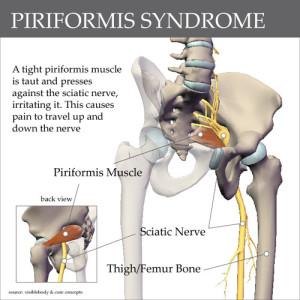SCIATICA vs. PIRIFORMIS SYNDROME

I found this to be a very good topic considering the majority of clients I see are either suffering from a pain in the neck or in the butt! (and are not referring to their significant others necessarily)
Sciatica and piriformis syndrome can seem quite similar, parularly in terms of symptoms, and this similarity in how they feel has caused considerable confusion for doctors and patients alike. Some individuals have stated that they are actually the same thing, but despite similarities in symptoms, the underlying causes of the two conditions are different.
Sciatica refers to irritation of the sciatic (often mis-spelled as syatic or psyatic) nerve, that arises from nerve roots in the lumbar spine. The most common cause of sciatic nerve irritation, or “true” sciatica is compression of one or more of its component nerve roots due to disc herniation or spinal degeneration in the lower lumbar region. Sciatica usually begins in the buttock area and, depending on the severity of the underlying nerve comression and inflammation, may extend down the entire leg to the ankle and foot.
Piriformis syndrome is sometimes called false sciatica, because instead of actual nerve irritation, it is caused by referral pain . The syndrome is caused by tight knots of contraction in the piriformis muscle, which attaches to the upper femur bone and then runs across the back of the pelvis to the outside edge of the sacrum, the triangular pelvic bone at the base of the spine. The symptoms of piriformis syndrome are very similar and may be indistinguishable from true sciatica.
In some cases, piriformis syndrome may cause true sciatic nerve irritation, as the sciatic nerve may run underneath or even through the middle of the piriformis, so contraction of the piriformis may produce sufficient compression of the sciatic nerve to produce actual nerve symptoms. This is one of the main sources of confusion when it comes to distinguishing true sciatica from piriformis syndrome.
As mentioned earlier, the symptoms of true sciatica are very similar to piriformis syndrome. Both cause pain, tingling, burning, “electrical shock” sensations, and/or numbness down the leg, often all the way to the foot. In addition, both sciatica and piriformis syndrome tend to be at least partially related to biomechanical functional problems in the joints of the back and pelvis and they may even be present simultaneously in the same person, so it an be difficult to tell them apart.
But since the most effective treatment for the two conditions varies signficantly, it is important to determine the correct diagnosis if at all possible. In most cases there is an easy way to distinguish between sciatica and piriformis syndrome.
In most cases, sciatica can be differentiated from piriformis syndrome with a couple of simple test maneuvers. To begin, from a seated position, one straightens the knee on the side of sciatic pain, holding the leg out straight and parallel to the floor, and if this position causes an increase in symptoms, it is a good indicator of true sciatica.
The second maneuver is performed in two parts. First, from the sitting position one bends the leg and pulls the knee on the painful side towards the same-side shoulder. In all but the most severe cases, there is usually no major increase in pain in this position. The second part of the maneuver is to pull the knee toward the opposite side shoulder. An increase in the sciatica-like symptoms is a strong indication of piriformis syndrome.
It is important to distinguish between sciatica and piriformis syndrome, because the treatment for the conditions varies, and getting the diagnosis right typically leads to more effective treatment.
Thank you Dr. George Best!
Properly stretching the piriformis muscle is very important, click on this link to see how
Recommended oils for Sciatica:
Peppermint, Roman Chamomile, Helichrysum and Thyme.
Wishing you Peace, Harmony and Balance.

